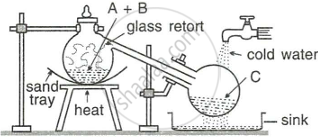Advertisements
Advertisements
प्रश्न
The figure given below illustrates the apparatus used in the laboratory preparation of nitric acid.

- Name A (a liquid), B (a solid), and C (a liquid). (Do not give the formulae).
- Write an equation to show how nitric acid undergoes decomposition.
- Write the equation for the reaction in which copper is oxidised by concentrated nitric acid.
उत्तर
- A: Conc. sulphuric acid
B: Sodium nitrate or Potassium nitrate
C: Nitric acid - \[\ce{4HNO3 ->[Heat][Sunlight] 4NO2 + 2H2O + O2}\]
- \[\ce{Cu + 4HNO3 -> Cu(NO3)2 + 2NO2 + 2H2O}\]
APPEARS IN
संबंधित प्रश्न
Ammonia is used in the Ostwald process.
Name the oxidising agent used in this process.
In which ratio reactants are taken in Ostwald process?
What happens when (Given balanced equation) :
Sulphar is added to hot and conc. HNO3?
What happens when (Given balanced equation):
Nitric acid is added to Kl (aq)?
During a thunderstorm, the rainwater contains nitric acid. The nitric acid is formed as a result of three chemical reactions. Describe or write balanced chemical equation for these three reactions.
When nitric acid is prepared by the action of concentrated sulphuric acid on potassium nitrate. what is the special feature of the apparatus used?
What is the special feature of the apparatus that is used in the laboratory preparation of nitric acid?
What would you observe in the following case:
Copper is heated with concentrated nitric acid in a hard glass test tube.
X, Y, and Z are three crystalline solids that are soluble in water and have common anion.
To help you to identify X, Y and Z, you are provided with the following experimental observations. Copy and complete the corresponding inferences in (a) to (e).
- A reddish-brown gas is obtained when X, Y, and Z are separately warmed with concentrated sulphuric acid and copper turning added to the mixture.
INFERENCE 1: The common anion is the ______ ion. - When X is heated, it melts and gives off only one gas which re-lights a glowing splint.
INFERENCE 2: The cation in X is either ______ or ______. - The action of heat on Y produces a reddish-brown gas and yellow residue which fuses with a glass of the test tube.
INFERENCE 3: The metal ion present in Y is the ______ ion. - When Z is heated, it leaves no residue. Warming Z with sodium hydroxide solution liberates a gas which turns moist red litmus paper blue.
INFERENCE 4: Z contains the ______ cation. - Write the equations for the following reactions:
- X and concentrated sulphuric acid (below 200°C). (One equation only for either of the cations given in INFERENCE 2)
- The action of heat on Y.
- Concentrated nitric acid is added to copper turnings kept in a beaker.
From the following list of substances, choose one substance in the case which matches the description given below:
Ammonium nitrate, calcium hydrogen carbonate, copper carbonate, lead nitrate, potassium nitrate, sodium carbonate, sodium hydrogen carbonate, zinc carbonate.
A Substance that gives off only oxygen when heated.
